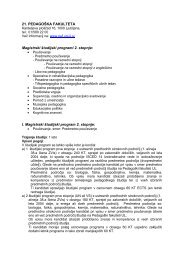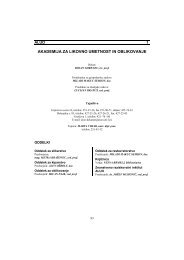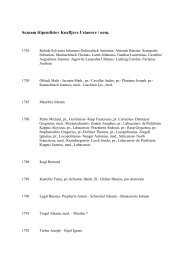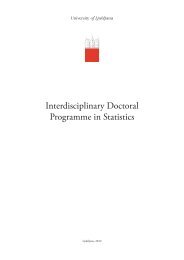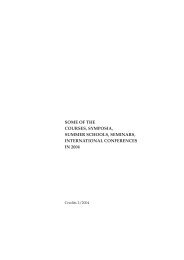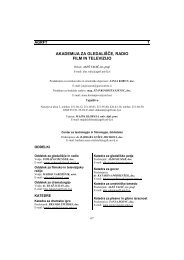Medicinska fakulteta Univerze v Ljubljani 1919–1945 - Univerza v ...
Medicinska fakulteta Univerze v Ljubljani 1919–1945 - Univerza v ...
Medicinska fakulteta Univerze v Ljubljani 1919–1945 - Univerza v ...
You also want an ePaper? Increase the reach of your titles
YUMPU automatically turns print PDFs into web optimized ePapers that Google loves.
The French Higher Education<br />
in Ljubljana and the Study of<br />
Medicine 1809-1813<br />
I<br />
The French nobility living on the eastern coast of the Adriatic<br />
Sea during the reign of the charismatic French leader Napoleon<br />
Bonaparte (1799-1814) [from 1804 Emperor Napoléon I le Grand<br />
(Napoleon I, the Great)] represent an especially significant era<br />
for the history of education even though it lasted only for a brief<br />
period of time� Revolutionary France first defended itself from<br />
outside attacks and inside revolts and then began its campaigns<br />
across Europe, including Slovenian territory� On its path, they<br />
more or less propagated the acquisitions of the French bourgeois<br />
revolution�<br />
Formally speaking, universities and faculties in France retained<br />
the form of medieval corporations until the revolution with<br />
the state not essentially intervening� In terms of content, they<br />
remained fortresses of scholastic mentality the same as throughout<br />
Europe� The revolution thus did not reform universities but in<br />
its radicalism abolished them or at least in theory proclaimed a<br />
general compulsory education, created a new secondary school,<br />
the école centrale (1795-1802) and after Napoleon’s rise to power<br />
in 1804 abolished this type of school and on primary level set<br />
up the college (a type of lower grammar school) and the lycée<br />
(a type of higher grammar school)� The entire system was fully<br />
formed in Napoleon’s Université Imperial (Imperial University)<br />
or Université de France or Université Napoléonienne, which was<br />
established in 1806 and obtained its final organisational form in<br />
1808� Université de France was not a university in the modern<br />
sense of the word but a corporation which united all French<br />
public schools from primary to higher education and which was<br />
governed by the “grand master”, the minister of education, who<br />
was helped by the “University Council”� In terms of organisation<br />
of the school system, France was territorially divided into<br />
about twenty “academies”, which were governed by the academy<br />
rector and the Academy Council� All schools in the academy’s<br />
territory and not just the higher education were subordinate to<br />
the rector as an appointed government official� Individual higher<br />
education institutions again began being labelled as faculties and<br />
old functions and academic levels were being restored� However,<br />
these schools remained predominantly unconnected� This French<br />
school system was completely bureaucratic, higher education<br />
teachers were government officials and the care for primary<br />
schools and colleges was left to the municipalities� Compared to<br />
pre-revolution times, visible progress is also seen in the subject<br />
matter taught and in the existence of numerous secondary and<br />
115<br />
Jože Ciperle<br />
higher schools for individual fields� The French revolutionary<br />
secondary and higher education system was predominantly aimed<br />
at educating officials, officers and other professionals and not at<br />
nurturing science� In the history of European universities, revolutionary<br />
France thus did not follow those European countries<br />
which used bourgeois revolutions and the new constitutional<br />
organisation to reshape medieval university corporations, giving<br />
them a new university anatomy in accordance with the principle<br />
of freedom of scholarship and science� All subsequent reforms<br />
of the French higher education were however directed towards<br />
connecting faculties and strengthening their autonomy�<br />
II<br />
The French troops first came to our territory in 1797 and later<br />
in 1805� On 14 October 1809, the Peace Treaty of Schönbrunn<br />
meant that Austria lost Carniola, the Villach district, the upper<br />
valley of the Drava River, Trieste, the Gorizia Region, the Austrian<br />
part of Istria and a part of Croatia and the Military Frontier south<br />
of the Sava River� Napoleon joined these territories with Dalmatia<br />
and the Venetian part of Istria into the Illyrian Provinces� Illyrian<br />
Provinces however, were not established by a decree of the senate<br />
(senatus-consultum) but by Napoleon’s decree, which gave special<br />
character to their relation with France� Only some of the French<br />
laws applied and their education system was thus also not a part of<br />
Napoleon’s Imperial University� The Illyrian Provinces had their<br />
own school administration, which was led from April 1810 by<br />
the general inspector of public schooling and the main author of<br />
all school reforms Rafaell Zelli, the former Director of the Zadar<br />
Lycée� However, Rafaell Zelli sent his reports to the “Grand<br />
Master” of the Université de France in Paris� From spring 1809,<br />
when the French came to Carniola, until autumn of the same year,<br />
schools were closed� In the 1809-1810 academic year, classes in<br />
primary and secondary education began in November but still<br />
followed old Austrian rules� It is known that there was an Austrian<br />
higher education lycée in Ljubljana that offered a two-year study<br />
of philosophy and a four-year study of theology� It was not until<br />
Marmont’ Decree (arête) was published on 4 July 1810 that the<br />
new school network was established� The decree foresaw primary<br />
schools (écoles primaries), 25 lower (gymnases) and 9 higher<br />
secondary schools (lycées) and the lycées in Ljubljana and Zadar<br />
were to be organised as central schools (écoles centrales)� With<br />
the 1810-1811 academic year, central schools began operating in



